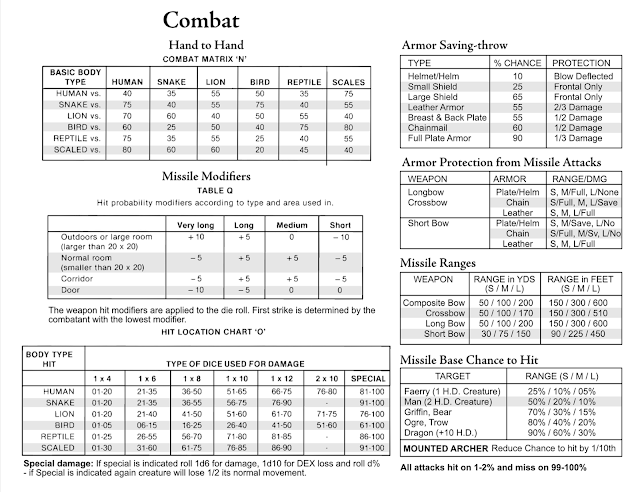Part 1 - Character Creation
First up it's become clear to me that an organized character sheet will be a helpful tool at the game table. Adventures in Fantasy utilizes a lot of calculations that adjust percentages. Getting to many of the required values requires some interesting math like this one for determining Hit Points.
 |
| Interesting Math |
Lots of little typos in this game along with missing details. Missing for example: listed equipment, specifically breastplate & backplate armour values. Presumably, this was to be included in an expansion. I'm going to do the old-school thing here and extrapolate. In this case, making Breastplate/Backplate to 55% Chance ( ½ normal damage).
 |
| Exhibit A Fig. 2 |
For the character sheet, I wanted it to have close to everything needed to run the character without having to refer to the rules. The idea being that the game session could be run with the character sheet and the GM screen alone.
For character generation, I altered the regular routine of rolling d% to 6d10+40 in order to end up with fairly capable pre-gens.
As for the pre-gen characters, for the education step, I roughly used the education time available by social status as per the rules. I skipped the process of rolling to check to see if the course was gained and just allowed the gain at the prescribed time for study.
The usual process involves the following formula.
((T/A)xC)-P
T= Time in months for coarse
A= Actual time in study
C= Coarse difficulty
P= Player intelligence
You can make an attempt with less time, a second attempt at the regular time and a final one with additional time.
You can see the pre-gen characters here.
Part 2 - Referee Screen and Reference Sheets
After the charter sheet design and extrapolation are done, I'll need to load my "World's Greatest Screen" with the available reference charts and make up some of my own. I'll want some crib notes for ability checks, specifically the influence check utilizing Charisma—it's a 5-step process that uses the same formula-based math as HP calculation!!! |
| The World's Greatest Screen by Hammerdog Press https://hammerdog-games.myshopify.com |
The screen mainly consisted of charts from the box set referencing aspects such as Creatures, Combat, Weapons & Equipment and Encounters. I added some of my own charts where the information was only presented in a block of text. For example, I created a chart for Armor Protection from missile attacks. I also included some notes in the screen for Characteristic Checks as well as some charts for Magic Points Cast per Turn and Magic Saving Throws.
Part 3 - The Adventure
My hope for this game at the event was to build off of the sample adventure in the Adventures in Fantasy game. To be fair it's not really a sample adventure, the book contains what I'd say are better referred to as examples of how to construct an adventure within a fantasy campaign world.
What I ended up doing was placing the start of the adventure in Bleakwood, the example setting presented in the Book of Adventure. I centered the main action around a heist. The player characters would have to retrieve a dragon egg from the tower of the local sorcerer Al-Haza. I utilized the tower contents as described in the example except for details I added on the forbidden top floor. From then on the rest of the material was original.
I wanted an interesting but basic dungeon crawl that could be completed in the allotted game time by a party with a curious temperament and a bit of luck. To that end, I structured some story details around a three level dungeon and populated it with various inhabitants and factions from the Book of Creatures and Treasure, increasing the difficulty as the levels descended culminating in a possible encounter with a Dragon!
I based the layout of the dungeon levels on the Twin Cities design style represented in "The Dungeons of Castle Blackmoor" from Zeitgeist Games (2006) and Greg Svenson's "Lost Dungeons of Tonisborg" (2021).
Overall I think the session we played at the convention was a success.
I'm going to take a stab at running Adventures in Fantasy again at ArneCon 3!

























